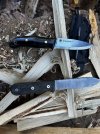You are using an out of date browser. It may not display this or other websites correctly.
You should upgrade or use an alternative browser.
You should upgrade or use an alternative browser.
CPK Kephart
- Thread starter Box_Opener
- Start date
- Joined
- Dec 1, 2016
- Messages
- 10,401
Kephart is an interesting design. It is the first knife that cut me as result of its design
I was testing it in the kitchen and since cutting geometry is quite thick for what I was doing, I was resorting thumb push cuts to go through the material I was cutting. I left the blade on the cutting board and when I picked it again, I tried to do another thumb assisted push cut but the feeling I got from the swedge scared me as I thought I was pushing against the edge. Without checking the orientation of the blade, I switched the orientation and tried thumb assited push cut again and this time I was really pushing against the edge. As a result of this I got a nasty cut on my thumb. I think the swedge and symmetric handle design is a dangerous combination for careless users or regular users when they are careless
Well I think it is safe to say I was much more careful when using the Kephart after that incident.
I am trying to puzzle this one out. Nathan's Kephart doesn't feature the typical double convex design that you see on a properly reproduced Kephart so I am trying to picture how far forward you had to have your thumb in order to feel a difference from the swedge. It isn't all that pronounced until you get to the last third of the blade towards the tip. As an additional point, did the lack of guard not deter you when you reoriented the knife in your hand? I am so used to having that guard nestled against my forefinger knuckle that I think I would have immediately felt something was amiss.
- Joined
- Nov 20, 2011
- Messages
- 4,684
I was thinking about this as well.I am trying to puzzle this one out. Nathan's Kephart doesn't feature the typical double convex design that you see on a properly reproduced Kephart so I am trying to picture how far forward you had to have your thumb in order to feel a difference from the swedge. It isn't all that pronounced until you get to the last third of the blade towards the tip. As an additional point, did the lack of guard not deter you when you reoriented the knife in your hand? I am so used to having that guard nestled against my forefinger knuckle that I think I would have immediately felt something was amiss.
In the end my assumption is he has one hand on the handle and is using his thumb from his other hand to put pressure on…
just the tip.
- Joined
- Dec 1, 2016
- Messages
- 10,401
I was thinking about this as well.
In the end my assumption is he has one hand on the handle and is using his thumb from his other hand to put pressure on…
just the tip.
I could see that maybe. Plus, folks from one person to another can grip their knives differently. The Kephart, especially visually, is a bland design but it's the subtleties that were incorporated in its time that make it stand out and what makes it remarkably difficult to reproduce if one is just looking at pictures.
To illustrate one difference between Nathan's and a more "true to period" reproduction, note the differences in the spines. I could see where someone might absentmindedly mistake the spine on the right for the edge - it's considerably thinner.

Tensegrity
Platinum Member
- Joined
- Jul 13, 2019
- Messages
- 962
I am trying to puzzle this one out. Nathan's Kephart doesn't feature the typical double convex design that you see on a properly reproduced Kephart so I am trying to picture how far forward you had to have your thumb in order to feel a difference from the swedge. It isn't all that pronounced until you get to the last third of the blade towards the tip. As an additional point, did the lack of guard not deter you when you reoriented the knife in your hand? I am so used to having that guard nestled against my forefinger knuckle that I think I would have immediately felt something was amiss.
Yes, I was pushing from the front end where the swedge very much felt like the edge.
I was cutting down a broccoli. I was holding the broccoli on one hand up in the air and I was using the thumb of the same hand to cut through the individual branches of the broccoli. I was using the tip and the thumb assisted push cut method as that kind of tasks requires delicate and controlled cuts especially with a thick and wide blade like the kephart.
No, I have not noticed the lack of the guard as I was so concentrated on the cutting the branches individually but not both at the same time. Also, I was not very familiar with a knife. I guess if I was using the knife long enough the lack of guard could ring a bell for me. But it a symmetric handle, so more tired and less careful you are the easier to make a mistake with such handle design.
- Joined
- Dec 1, 2016
- Messages
- 10,401
Yes, I was pushing from the front end where the swedge very much felt like the edge.
I was cutting down a broccoli. I was holding the broccoli on one hand up in the air and I was using the thumb of the same hand to cut through the individual branches of the broccoli. I was using the tip and the thumb assisted push cut method as that kind of tasks requires delicate and controlled cuts especially with a thick and wide blade like the kephart.
No, I have not noticed the lack of the guard as I was so concentrated on the cutting the branches individually but not both at the same time. Also, I was not very familiar with a knife. I guess if I was using the knife long enough the lack of guard could ring a bell for me. But it a symmetric handle, so more tired and less careful you are the easier to make a mistake with such handle design.
I apologize, I am still having some trouble picturing this. That's not your issue though - I suspect that the breakdown might have to do with our differing familiarity with the knife pattern.
- Joined
- Dec 1, 2016
- Messages
- 10,401
I will say that the Kephart isn't the most efficient user in the kitchen but I do like to utilize it there on occasion and it gets the job done. It's a great all around belt knife that was designed to do things that were expected of a late 19th/early 20th century sportsman. I would think most folks would be disappointed in its performance doing modern "bushcraft" tasks but it simply wasn't intended for those kinds of activities. Through the modern lens, the FK2 is the superior knife.
I still love the Kephart though and I love that Nathan decided to produce one.

I still love the Kephart though and I love that Nathan decided to produce one.

SwarthyGnome
Gold Member
- Joined
- Nov 1, 2018
- Messages
- 1,533
tinfoil hat timmy
Gold Member
- Joined
- Aug 21, 2014
- Messages
- 18,580
I'll do that soontinfoil hat timmy can you post more pics of your Kephart butter knife?
I didnt think that it counted to be honest
tinfoil hat timmy
Gold Member
- Joined
- Aug 21, 2014
- Messages
- 18,580
tinfoil hat timmy
Gold Member
- Joined
- Aug 21, 2014
- Messages
- 18,580
Imagine holding a whole broccoli on your left hand and using the left hand thumb to push on the swedge to cut the individual branches of the broccoli with the very front portion of the blade (the direction of motion is from down to up). Of course, meanwhile right hand will be holding the handle of the knife. And yes I have pretty big hands to be able to hold whole broccoli and use the thumb to the push cutI apologize, I am still having some trouble picturing this. That's not your issue though - I suspect that the breakdown might have to do with our differing familiarity with the knife pattern.
I will say that the Kephart isn't the most efficient user in the kitchen but I do like to utilize it there on occasion and it gets the job done. It's a great all around belt knife that was designed to do things that were expected of a late 19th/early 20th century sportsman. I would think most folks would be disappointed in its performance doing modern "bushcraft" tasks but it simply wasn't intended for those kinds of activities. Through the modern lens, the FK2 is the superior knife.
I still love the Kephart though and I love that Nathan decided to produce one.

I found DEK 3 awesome to use in the kitchen. It slides through anything easily and I never worry about edge damage unless I am doing something I was not supposed to do with a knife.
I would not imagine using a thumb to assist a push cut with DEK3 though. That un sharpened swedge on DEK3 is dangerous!
- Joined
- Mar 27, 2012
- Messages
- 860
I finally got out camping weekend-before-last. The Kephart is much, much better at battoning kindling (or however you spell the verb of baton) than my Spyderco Bushcrafter. Probably because it’s thinner with a much taller grind. Super-fun. However, as expected, the spine is no good for a fire steel. Couldn’t shave much or get hardly a spark.
It seemed to make feathers just about the same as the Bushcrafter. Very different grinds on the two of course.
Would CPK be willing to square up the back of that puppy if I sent it in for a fee? Are they that sort of house?
I had to use the dedicated fire-steel striker and pouted for hours afterword. Love the Kephart though. It’s a keeper.

Disclaimer: I’m not a bushcrafter…just a car-camper that likes to play with fire.
It seemed to make feathers just about the same as the Bushcrafter. Very different grinds on the two of course.
Would CPK be willing to square up the back of that puppy if I sent it in for a fee? Are they that sort of house?
I had to use the dedicated fire-steel striker and pouted for hours afterword. Love the Kephart though. It’s a keeper.

Disclaimer: I’m not a bushcrafter…just a car-camper that likes to play with fire.
- Joined
- Jul 3, 2019
- Messages
- 12,120
- Joined
- Jul 3, 2019
- Messages
- 12,120
I've already been trying to sort out how CPK scheduling and purchases work.You're in trouble now, Dan. Welcome.
I've never been so impressed with a "simple" fixed blade knife.
Try "Barkeepers Friend" for some trails. If that doesn't get it, then Brasso. Then go for polishing/stropping compounds on up. (Go light since you want to subdue or dull some of your surface trails that may not be scratches, but not take the finish off - but it looks like it may be too late for that.) Have a good one.
[Or see Nathan below - Leave it alone...]
Nathan the Machinist
KnifeMaker / Machinist / Evil Genius
Moderator
Knifemaker / Craftsman / Service Provider
- Joined
- Feb 13, 2007
- Messages
- 15,704
You're not going to have any success filing that material


